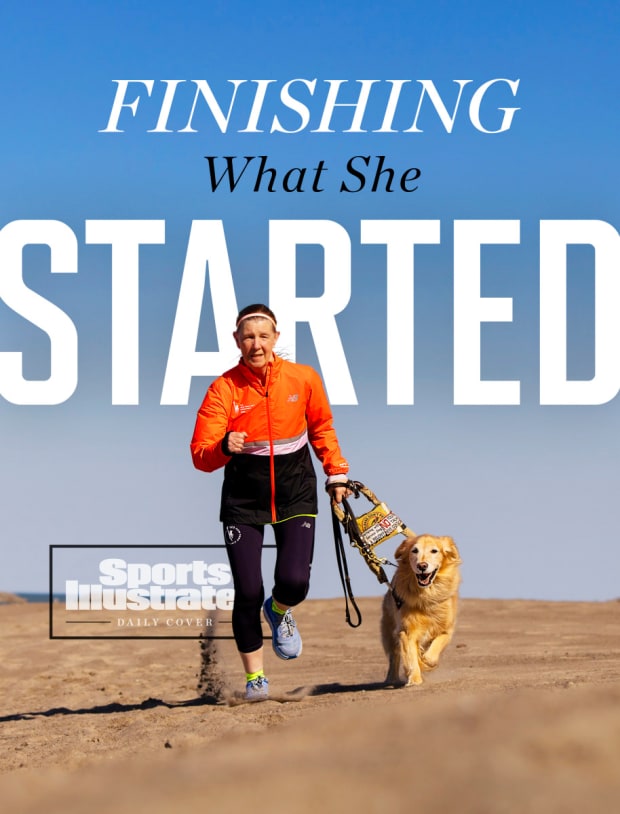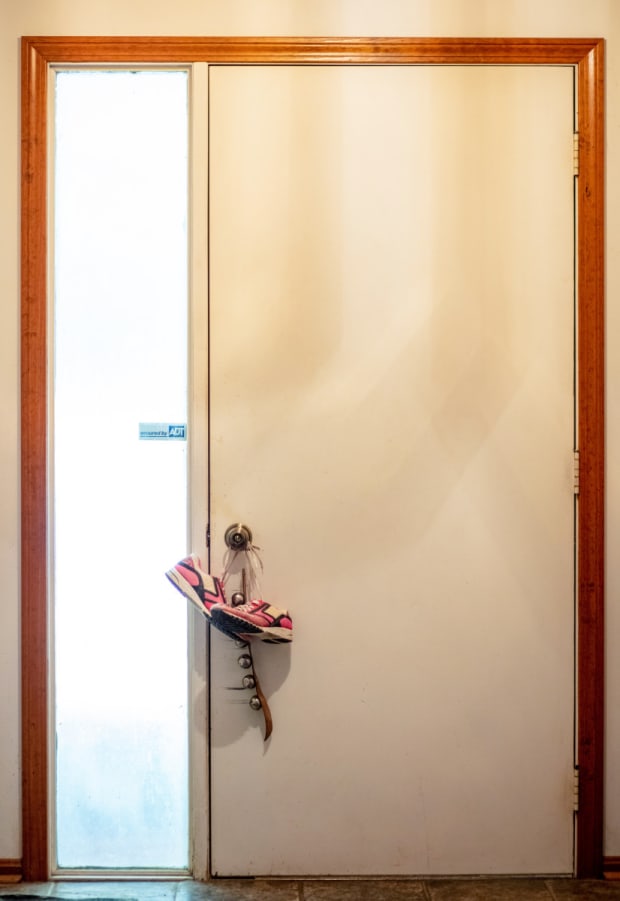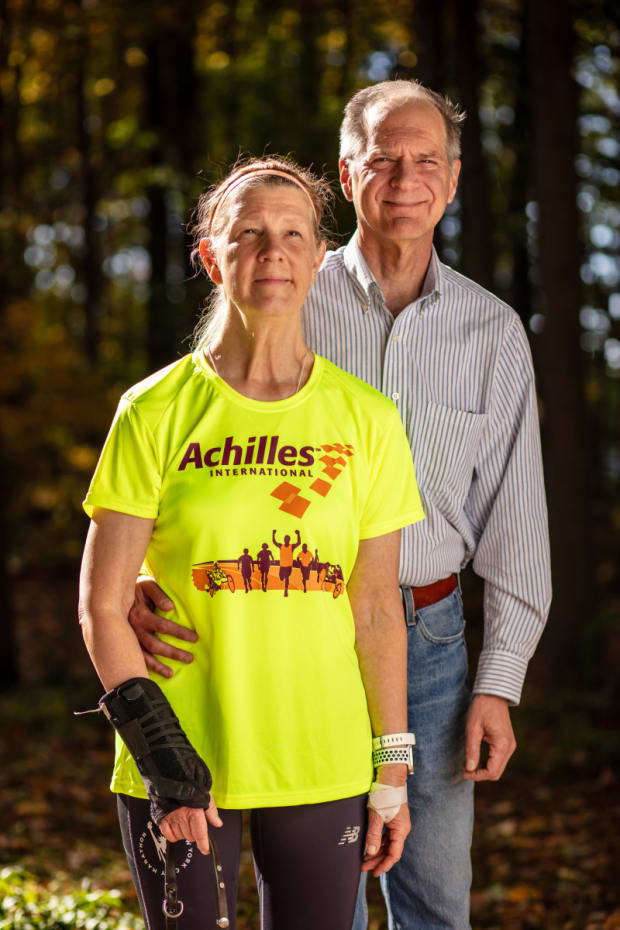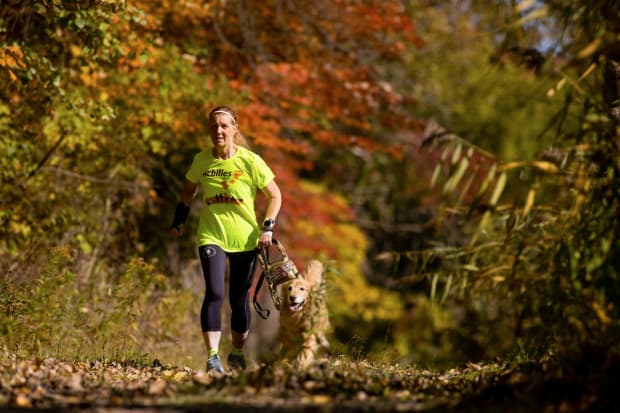Just inside the front door of Passle Helminski’s home is a pair of Brooks running sneakers with years of miles and memories seeped into their fabric. Helminski, 68, used to wear the hot-pink size 8s zipping around her Erie, Pa., neighborhood, where she trained as a competitive racewalker. She laced them up for sessions at nearby Presque Isle State Park, too, where in the summer of 1993, she regularly strided out 13-mile loops with her older sister, Bonnie, starting before dawn. One straight leg down, then another, as fast as they could without losing contact with the ground. With miles hovering around 9 minutes—a respectable pace for somebody running a marathon—the loop could take around two hours. “We can do it. Let’s keep going,” Bonnie remembers Passle always telling her.
Helminski planned on wearing the sneakers in the 1993 New York City Marathon, which she had entered alongside Bonnie. And she had them on one evening that July for a training walk in Erie County. By the time she finished and returned to her gray Jeep in a school parking lot, it was getting dark. Helminski says a man suddenly appeared, surprising her. He assaulted her, striking her in the neck with his hand: a blow which caused a tear in her left carotid artery—one of the two vessels that supplies blood to a person’s neck, face and brain—and within 12 hours, a stroke.

LEBRECHTMEDIA/Sports Illustrated
Twenty-nine years later, Helminski tries not to dwell on the most traumatic moment of her past. But she also doesn’t forget. Every morning, as she takes her service dog, Zoey, out for exercise—sometimes a run, sometimes a walk, sometimes a racewalk and sometimes a combination of the three—in their neighborhood, she sees the sneakers sitting beside her front closet door. “They empower me to put one foot in front of the other,” she says. “They empower me to accomplish what I want to accomplish.”
That November’s race was supposed to be her first marathon. Her time would determine whether she would qualify for the United States Olympic Trials in racewalking. Aspirations of competing on a global stage have long since faded. This Sunday, however, Helminski will look to finish what she started three decades earlier and race in the New York City Marathon. She had to relearn how to walk and relearn how to speak after her attack. Now, she’s trained herself once again to compete. “It’s worth it,” she says. “Having the courage to step out of my comfort zone and say, ‘I’m going to approach this, even though it almost cost me my life.’”
The Brooks sneakers, with their speckles of dirt and soles reattached by hot glue, have been swapped out for more supportive Hokas. Helminski has endured all manner of physical challenges since she first set out to traverse 26.2 miles on a fall morning in New York. But “other than that, she’s very much the same person,” her husband Ron Helminski says. “The same drive. The same determination. Don’t tell her she can’t do something because she’s gonna show you she can.”

LEBRECHTMEDIA/Sports Illustrated
Bonnie likes to say that as a child, Passle never walked: “She crawled and then she ran. It was always full speed ahead.” Often, Helminski trekked up a hill in their neighborhood—one that her older sister describes as “like a ski slope”—with roller skates in hand, so she could shoot down it as fast as possible. At the urging of her mother, Anne, who wanted her to blow off steam, she played basketball, football and baseball with kids who lived nearby. She crawled into the woods across the street from their three-bedroom house and tried to catch crawfish in the creek. “I was born with ants in my pants,” Helminski says.
The first name Helminski currently uses evolved from embracing a mistake: A first-grader with a stutter, she struggled to remember the word “castle” while participating in a school play that was spoofing Cinderella. So father, Al, and her sister suggested she say the word “palace” instead. When time came for the performance itself, though, she smushed the two magisterial residences together. “She is a passle. A passle of goodness and energy,” Bonnie says.
Helminski’s interest in racewalking also developed out of an apparent setback. Then a few years out of college, she was in her mid-20s when she tore the anterior and superior ligaments in her left hip while practicing for a community performance of The Nutcracker. Her doctor said she needed to visit weekly to have her hips realigned in order to avoid a replacement later in life. Helminski liked to run as a hobby, but those days were over, he told her. The doctor said she could, however, walk as fast as she wanted.
But it took having an Olympic-level runner as a neighbor to truly set her on her path.
Barb Filutze, who ran the marathon at the U.S. Olympic Trials for the ’84 and ’88 Games, had recently moved a half-block away from Helminski in Erie. Filutze often ran or biked through the neighborhood for her own training, and she first told Helminski and Bonnie about the sport of racewalking. Helminski dove in—and, naturally, dragged her sister with her. Heminski’s new pursuit offered her the freedom to move again, not to mention shake off the ants that had been gathering in her pants since the injury. “Just because I had a ballet mess-up, that turned into another gift for me,” Helminski says.
Filutze, who died in August, was primarily a runner, not a racewalker, but she knew more than enough to be an effective coach. Early on, Filutze noted Helminski had solid form and encouraged her to keep practicing. (In racewalking, different from running, contact with the ground must be maintained at all times, and an athlete’s supporting leg must be straight until it passes under the body.) Helminski, Bonnie remembers, hung on Filutze’s “every word.” Ahead of the 1993 New York City Marathon, Helminski trained daily, eyeing a spot in the following year’s U.S. Olympic Trials. She knew the Olympics were a pipe dream, but even qualifying for the trials would be a thrill.
Two or three times per week, Helminski would work out with Filutze and other members of the Erie Runners Club. She was alone, though, on the evening that her training came to an abrupt halt.

Helminski finished her racewalk that July evening—she recalls doing more than a 10K—and was returning to her car in an empty parking lot when she noticed a man standing by it. They made small talk, she says, but it “quickly went down hill.” He struck her in the left side of her neck, she says, a blow Helminski later learned dissected her carotid artery. Doctors found damage in the right side of her neck as well.
What transpired next was a blur, she says, but Helminski remembers coming-to on the ground with the man no longer there.
With her assailant gone, she says she climbed into her car and drove herself home, a trip she recalls as less than 30 minutes, figuring that she’d go home and get her insurance card before heading to the hospital. Helminski describes feeling a “headache from hell” and thinking upon arriving at her house that if she closed her eyes for a minute the pain from her head would go away.
She used the bathroom, but upon walking into the hallway outside of it, she fainted. Her mother, who had gone to bed early that night, found her on the floor the next morning. Anne phoned for an ambulance and called Ron, then her fiancé.
“How dire it appeared in the moment, it was terrifying,” he says. “You think of what you had planned and how those plans weren’t going to come out how you anticipated.”
Says Bonnie: “When I first saw her, I never thought she would recover.”

Shortly after Bonnie arrived back at her New York City hotel on the afternoon of Nov. 14, 1993, her room’s phone rang. Who in the world is calling me? she thought to herself.
“Are you O.K? Did you do it?” the voice on the other line asked. “I can’t believe you did this for me.”
For 26.2 miles that day, Bonnie traversed New York City’s five boroughs with the words “For Passle” handwritten in hot pink marker on the back of her white T-shirt. Confused by her sister’s name, Bonnie recalls, onlookers shouted passe le, a French (and marathon-appropriate) term meaning “pass it.” Still struggling to string together full sentences, Passle had phoned to congratulate Bonnie. The two burst into tears 400 miles apart.
Passle was back home by the time she called Bonnie, though her mother had to dial for her. Three months after her stroke, Passle remained in the early stages of her recovery. Initially, in the hospital, she says, doctors pumped her stomach, thinking she had suffered an overdose. She couldn’t speak to tell them not to. She couldn’t move her right side and was able only to shake her head up and down. One doctor, Passle remembers, even told her husband that she was going to die within 48 hours and that if she didn’t, she would be in a vegetative state.
After less than two weeks she was discharged.
“The fact she was as healthy as she was and as strong as she was helped her,” Ron says. Still, he adds, “It was a long, painful process.”
Part of that process included regaining her physical strength. Helminski’s insurance helped offset initial speech-therapy costs, but by the time of that year’s marathon, she was relearning how to speak on her own. She never had formal physical therapy after leaving the hospital. Nevertheless, she had dreams of racing again. “And then I’d get out of bed, and reality hit.”
She would trip over her right drop foot, which to this day she has some occasional difficulty lifting. “I was bound and determined to do my own pony tail and put clips in my hair,” she says. She merely wanted to slip on her shoes with two hands. After a few months, she was able to string a few words and sentences together. A year out, she was able to alter her own wedding dress, which she’d stitched together from different fabrics, to marry Ron. But it took nearly two years before she could hold a full conversation.
Helminski says in the couple of years following the incident she had discussions about pursuing civil or criminal charges, but never did. She had no witnesses and could not immediately relay the details of the attack to anyone due to her stroke.
“You’re embarrassed. You’re enraged. You’re all of the emotions,” she says. “But I’m here and I’m doing things again.”
It took her more than a year to merely walk 100 yards to her mailbox without tiring, the journey from her door across her yard feeling like a marathon in itself. By 2000, though, she had regained enough strength to complete her first 5K race since the stroke. Passle, Bonnie recalls, started out fast despite her urging her not to, and set the pace for them both. Ron waited anxiously at the finish line, not knowing how long they would take. I never thought I would see this day again, Bonnie remembers thinking as they crossed the finish line together.
“As usual, [Passle] came through and did what she said she was gonna do,” Ron says.

A few minutes before noon on a Monday a month before the 2022 New York City Marathon, Helminski strides into a building that houses Voices for Independence, an organization that provides a number of services to empower people with disabilities. She still suffers some lingering effects from the stroke: in addition to the drop foot, she has limited mobility in her neck and experiences occasional aphasia and vision impairment. She has already spent an hour on her elliptical machine at home this morning, but she is at Voices for a cross-training session with Brian Petersen, the site’s director of fitness and wellness.
Even since her 2000 5K, Helminski has suffered several more injuries: she has had hairline fractures in her right tibia (a dog knocked her over), broken her right arm (after slipping on ice), broken her nose (another dog incident, this one during a race) and had left eyelid surgery (an accident involving fiberglass). She has still managed to compete in a number of races, around six per year, mostly 5- or 10K’s, doing so in large part to encourage peers of hers to participate.
For around an hour at Voices for Independence, Helminski runs through a series of exercise circuits that includes TRX squats, kettlebell swings and medicine ball twists. At one point, Petersen instructs her to practice her racewalking—she repeats heel toe, heel toe, heel toe out loud to herself to maintain focus as she does. “The amount of road work she’s put in this year alone trumps anything I can imagine,” Petersen says.
Helminski never thought she would have the chance to participate in the New York City Marathon again. Securing entry in the race is often a long-odds proposition, but last spring she entered the lottery for a bib at the encouragement of peers at Achilles International, an organization she is a part of that helps people with disabilities participate in endurance events.
When she told her sister that she’d won a spot and was going to take part in this November’s marathon, Bonnie was initially hesitant. “I didn’t want it to be too much for her,” she says. Yet Passle persisted and made clear she was going to complete what she set out to do decades earlier.
For the past four-plus months, Helminski has seldom taken a day off from her training. Her golden retriever Zoey often serves as a companion (though on race day Helminski will have a human guide supplied by Achilles International). She says neighbors of hers have grown used to seeing them speed past their windows, no matter the weather. “That’s why I go through so many shoes,” she says.
“Life is to be enjoyed. I love giving energy back to the universe when I’m running or walking. I know what it’s like to be down and out and I don’t want anybody to feel that way. I just want to try and be uplifting to other people if I can.”
For decades, she has put that attitude to practice in her racewalking, and with her involvement in the Pennsylvania Rehabilitation Council, Erie’s Office of Vocational Rehabilitation Citizen Advisory Committee and the Erie County Elderly and Disabled ParaTransit Committee. Helminski is also an artist, crafting pieces—a few of which are scattered around her house—out of whatever materials she has handy. She serves as a volunteer art teacher at Erie’s Inner-City Art House, where her class is called, simply, Creative Chaos. “You cannot make a mistake in my class,” she tells her students. “A mistake would be a new art form.”
Helminski says it might take her six to seven hours on Sunday to finish the race, as opposed to the sub-four-hour mark she targeted three decades ago. But crossing the finish line in itself would be a major victory. Plus, even though she quips that she’s “the box turtle covered with molasses trying to run through peanut butter,” she says she is already interested in exploring what it would take to run in the Boston Marathon in the future.
The race in front of her is looming, however, and a few weeks before New York she is still figuring out which gels and gummies she might want to take for an energy boost on her 26.2-mile journey. As she walks into a local running store to make a selection, she beams with pride telling the store’s clerks that she is running an upcoming marathon.
“I’m here and I’m doing things again,” she says. “Getting up. Putting on my shoes. Using both hands to tie my shoelaces. Going out there and gliding or racewalking or running a few steps, it makes my soul smile.
“It makes me want to spread joy.”
Correction: A previous version of this story incorrectly said Barb Filutze competed in the 1988 Olympics; she competed only in the U.S. Olympic Trials that year.







